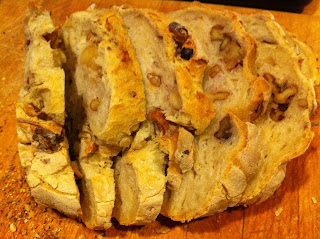Franny was recently asking me about sourdough starter wondering if she made it in Portland would it be different than San Francisco sourdough. Technically, the answer is yes. Apparently during the Gold Rush era, the Boudins, a French family of bakers, settled in San Francisco and discovered that the sourdough they made in San Francisco was especially unique so they set about baking... and raking in the cash.
I've seen some very complicated recipes for sourdough starter, but it's actually very simple. Here's my method:
Make your starter at least 3 days before you intend to bake with it. The following recipe is for a gluten-free sourdough starter, made from rice flour, which helps enormously with getting gluten-free breads to rise properly. One can substitute bean, wheat or rye flours for the rice flour, if desired.
Sourdough Starter
2 1/2 tsp dry yeast granules
1 cup lukewarm water
1 tsp potato (instant flakes, potato flour, or cooked russet)
1 tsp sugar
1 cup rice flour
The sugar feeds the yeast so don't leave it out, but you can substitute a few crushed grapes if you prefer. You can probably get away with leaving out the potato flour, if you don't have it.
In a glass jar or potter crock (no metals!) mix the potato into the water, then dissolve the yeast into it. Put the lid on and shake to mix. Add the sugar and the rice flour, cover and shake again. Take the lid off and stir whatever hasn't mixed thoroughly from the shaking then, leaving the lid off, cover with a paper towel and leave the starter sitting on your kitchen counter for at least 3 days, stirring occasionally. Over time, it will start to bubble and give off a pungent fragrance - this is the good stuff! (Take out the grapes at this point, if you used them). The longer you leave it, the more flavor it will impart. A layer of liquid will eventually form on top so be sure to stir it well before you use it. I add 1/2 cup to any bread recipe I make - it adds great flavor and helps the loaf rise up nice and fluffy.
Replenish the starter after each use by adding 1 cup of lukewarm water for every 1 1/2 cups of rice flour, or variations on that ratio as needed.
Store in the refrigerator indefinitely.
 |
| Superloaf! |
Note from Franny: Erin, I got your sourdough starter in the mail, along with all those gorgeous Meyer lemons, and everything else you sent. You're the best!
So, I made my 5 minute artisan bread last night and, as sort of an afterthought, I tossed in most of your sourdough starter. I don't know what I was thinking, adding all that extra yeast, but it came out great! Since you need a source of steam to create the nice crust -- and I'm always trying to figure out the best way to make more steam -- I placed a small cast iron pan filled with water on the floor of the oven. I also added walnuts, and the result was a wonderful, chewy loaf of bread. It's really quite remarkable, if I do say so myself. It seems as though each loaf is better than the last. Here's a picture of my latest masterpiece >>>
While I was baking, I watched an Ashton Kutcher movie on my computer in the kitchen (the one where he and Natalie Portman are friends-with-benefits trying hard not to fall in love with each other -- No Strings Attached). It was truly terrible.

















